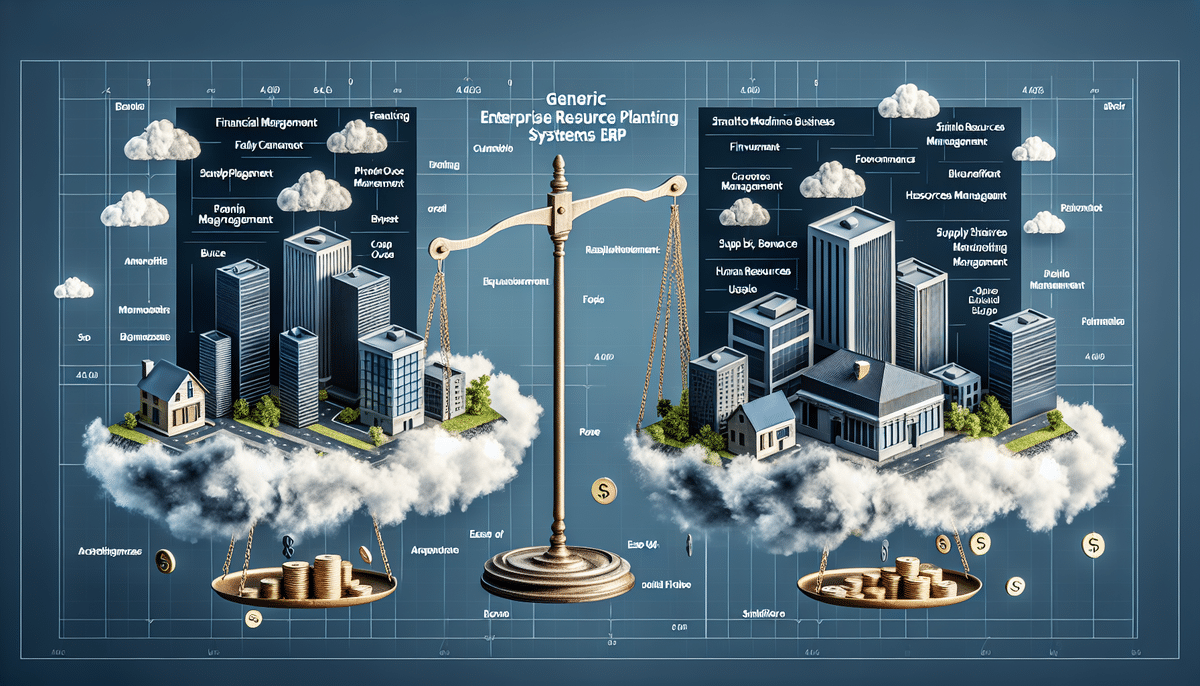Sage Intacct vs NetSuite ERP
In today's digital landscape, selecting the right Enterprise Resource Planning (ERP) system is crucial for businesses aiming to streamline operations and drive growth. Sage Intacct and NetSuite ERP are two leading contenders in the ERP market, each offering a robust suite of features tailored to different business needs. This comprehensive comparison delves into their features, pricing, implementation processes, user interfaces, customization options, integration capabilities, and customer support, highlighting the pros and cons of each. By the end of this guide, you'll be equipped with the insights necessary to make an informed ERP decision for your organization.
What is Sage Intacct?
Sage Intacct is a cloud-based accounting software designed primarily for small to mid-sized businesses. It offers automation for core financial processes, streamlined multi-entity management, advanced revenue recognition, and subscription billing. Additional features include accelerated close processes, customizable reporting, and dynamic dashboards, providing enhanced financial visibility and control.
Sage Intacct integrates seamlessly with various business applications such as Salesforce, Expensify, and Bill.com, creating a comprehensive financial management ecosystem. Its intuitive interface and mobile accessibility allow users to manage finances efficiently on-the-go. According to a [Forrester report](https://www.forrester.com/report/SageIntacct), Sage Intacct is recognized for its robust financial management capabilities, making it a preferred choice for growing businesses seeking scalability and precision.
What is NetSuite ERP?
NetSuite ERP is a comprehensive cloud-based ERP system catering to businesses of all sizes, from startups to large enterprises. It encompasses a wide range of modules, including financial management, order management, inventory and warehouse management, human resources, customer relationship management (CRM), and eCommerce. NetSuite offers real-time visibility into key business operations, enabling informed decision-making and operational efficiency.
One of the standout features of NetSuite ERP is its ability to automate and streamline complex business processes. By leveraging modules for financial reporting, supply chain management, and inventory control, companies can reduce manual errors and enhance productivity. Its cloud-based architecture facilitates seamless collaboration and data access from anywhere, which is especially beneficial for organizations with remote or distributed teams. NetSuite's scalability and flexibility have been recognized in various [industry analyses](https://www.gartner.com/en/information-technology/glossary/enterprise-resource-planning-erp), positioning it as a top choice for businesses with evolving and intricate operational needs.
Key Differences Between Sage Intacct and NetSuite ERP
The primary distinction between Sage Intacct and NetSuite ERP lies in their target audiences and scalability. Sage Intacct is tailored for small to mid-sized businesses, offering a focused suite of financial management tools. In contrast, NetSuite ERP caters to a broader range of businesses, including large enterprises, providing a more extensive set of functionalities beyond financials, such as supply chain and CRM.
Another significant difference is their pricing models. Sage Intacct employs a subscription-based pricing structure, where costs are determined by the number of users and required modules. This approach tends to be more cost-effective for smaller organizations with specific needs. On the other hand, NetSuite ERP utilizes a tiered pricing model that varies based on the scope and size of the business, making it more suitable for larger enterprises with complex requirements.
Features Comparison: Sage Intacct vs NetSuite ERP
Sage Intacct Features
- Accounts Payable and Receivable
- General Ledger
- Financial Reporting and Analysis
- Cash Management
- Order Management
- Project Accounting
- Multi-Entity and Global Consolidations
NetSuite ERP Features
- Financial Management
- Order Management
- Production Management
- Supply Chain Management
- Human Resources Management
- Customer Relationship Management (CRM)
- eCommerce
- Advanced Analytics and Reporting
While both systems offer comprehensive financial management features, NetSuite ERP provides a broader range of modules suitable for managing various aspects of a large organization. Sage Intacct, conversely, is praised for its user-friendly interface and ease of navigation, making it ideal for businesses without extensive ERP experience.
According to a [Gartner report](https://www.gartner.com/en/documents/4000501), NetSuite ERP is renowned for its scalability and flexibility, accommodating the needs of growing enterprises. Sage Intacct, while not as expansive, excels in delivering specialized financial solutions with a focus on usability and quick deployment.
Pricing Comparison: Sage Intacct vs NetSuite ERP
Sage Intacct adopts a subscription-based pricing model, starting at approximately $400 per month for the base package. Additional users and modules increase the overall cost, making it a scalable investment for growing businesses.
NetSuite ERP employs a tiered pricing structure, with initial costs around $10,000 annually and additional expenses based on the number of users, customization, and selected modules. This model reflects its comprehensive feature set and is better suited for larger organizations with more complex needs.
When evaluating costs, it's essential to consider both the initial and long-term expenses. While Sage Intacct may present a lower entry cost, expanding its functionalities can lead to higher cumulative costs. NetSuite ERP's higher upfront pricing is offset by its extensive features and the ability to handle complex, large-scale operations efficiently.
Implementation Process and Timeline
Sage Intacct Implementation
Sage Intacct is known for its relatively swift implementation process, typically ranging from six to eight weeks. This expedited timeline is facilitated by its user-friendly design and the availability of pre-configured modules that can be quickly tailored to a business's specific needs.
NetSuite ERP Implementation
Implementing NetSuite ERP is generally more time-consuming, often taking between six months to a year. The extended timeline accounts for the system's complexity and the high level of customization that larger organizations may require. The process includes data migration, employee training, and ensuring seamless integration with existing systems.
While Sage Intacct offers quicker deployment, NetSuite ERP's comprehensive implementation process ensures that the system is fully adapted to the intricate needs of larger businesses. The choice between the two should align with your organization's size, complexity, and readiness for an ERP transformation.
User Interface and Ease of Use
Sage Intacct
Sage Intacct boasts a clean and intuitive user interface, prioritizing ease of navigation and accessibility. Its design minimizes the learning curve, enabling users to quickly adapt and efficiently perform their tasks. The system's dashboards are customizable, allowing users to focus on the metrics that matter most to their roles.
NetSuite ERP
NetSuite ERP features a more complex interface due to its extensive range of functionalities. While this complexity offers greater flexibility and control, it can require more time for users to become proficient. Comprehensive training and support are often necessary to maximize the system's potential.
According to user reviews on [G2](https://www.g2.com/), Sage Intacct consistently receives high marks for its user-friendly design, whereas NetSuite ERP is praised for its depth and customization capabilities despite being more challenging to navigate initially.
Customization Options
Sage Intacct
Sage Intacct provides customization options primarily focused on financial reports, dashboards, and workflows. Users can tailor these elements to align with specific business processes and reporting requirements, enhancing the system's relevance to their operations.
NetSuite ERP
NetSuite ERP offers extensive customization capabilities, including custom fields, forms, workflows, and scripts. This level of customization allows businesses to modify the system to fit unique processes, integrate with other software, and adapt to changing business needs seamlessly.
For organizations seeking high degrees of customization, especially those with complex or unique workflows, NetSuite ERP presents more robust options. Conversely, businesses looking for straightforward financial management with some flexibility may find Sage Intacct sufficient.
Integration Capabilities
Sage Intacct
Sage Intacct integrates with a variety of third-party applications, enhancing its functionality and allowing businesses to create a cohesive technology ecosystem. Key integrations include:
- Salesforce for CRM
- Expensify for expense management
- Bill.com for accounts payable and receivable
- Avalara for tax compliance
NetSuite ERP
NetSuite ERP offers a wide range of integration options, supporting connections with popular CRM, eCommerce, and other enterprise applications. Notable integrations include:
- Salesforce for enhanced CRM capabilities
- Magento for eCommerce
- Oracle Integration Cloud for broader enterprise integrations
- ShipStation for order fulfillment
Both ERP systems support extensive integrations, but NetSuite ERP's broader range caters to the diverse needs of larger enterprises, enabling more complex and varied integration scenarios.
Customer Support and Training Options
Sage Intacct
Sage Intacct provides a variety of customer support and training resources, including:
- Comprehensive online documentation and knowledge base
- Webinars and live training sessions
- In-app assistance and support tickets
- Dedicated customer success managers for personalized support
NetSuite ERP
NetSuite ERP offers robust customer support and training options, such as:
- Extensive online resources and user community forums
- Structured training programs and certifications
- 24/7 customer support through multiple channels
- Personalized support from dedicated account managers
Both platforms emphasize customer support, but NetSuite ERP's extensive resources and round-the-clock support cater to the needs of large enterprises requiring constant assistance and comprehensive training.
Pros and Cons of Using Sage Intacct
Pros:
- User-friendly interface with intuitive navigation
- Quick implementation timeline
- Robust financial management and reporting
- Scalable for growing small to mid-sized businesses
Cons:
- Limited customization compared to larger ERP systems
- May not adequately support very large enterprises with complex needs
- Additional costs for extra users and modules
Pros and Cons of Using NetSuite ERP
Pros:
- Comprehensive feature set covering various business operations
- Highly scalable and suitable for large enterprises
- Extensive customization and integration options
- Real-time visibility and advanced analytics
Cons:
- Higher cost may be prohibitive for small businesses
- More complex interface requiring thorough training
- Longer implementation timeline
Which ERP System is Better Suited for Small Businesses?
Sage Intacct is particularly well-suited for small to mid-sized businesses seeking an affordable, easy-to-use ERP solution focused on financial management. Its subscription-based pricing and quick implementation make it an attractive option for organizations with limited budgets and the need for rapid deployment. The system's user-friendly interface allows smaller teams to manage their finances effectively without extensive ERP expertise.
Which ERP System is Better Suited for Large Enterprises?
NetSuite ERP is designed to meet the demands of large enterprises with complex operations and extensive customization requirements. Its comprehensive suite of modules covers various business functions beyond finance, such as supply chain, inventory, and CRM, making it ideal for organizations with multifaceted processes and a need for scalable solutions. Despite its higher cost and longer implementation time, NetSuite ERP's robust capabilities provide significant value for large-scale businesses.
Final Verdict – Which ERP System Should You Choose?
The decision between Sage Intacct and NetSuite ERP ultimately hinges on your business's unique needs, size, and budget. If you're a small to mid-sized business seeking a cost-effective, user-friendly solution with strong financial management capabilities, Sage Intacct is an excellent choice. Conversely, if you're a large enterprise requiring a comprehensive, scalable ERP system with extensive customization and integration options, NetSuite ERP may be the better fit despite its higher investment and longer implementation process.
Conclusion – Choosing the Right ERP System for Your Business
Selecting the appropriate ERP system is a pivotal decision that can significantly impact your business's efficiency and growth trajectory. Sage Intacct and NetSuite ERP each offer distinct advantages tailored to different organizational needs. By carefully evaluating factors such as features, pricing, customization, integration capabilities, and support, you can identify the ERP solution that aligns best with your business objectives and operational requirements. Investing time and resources in this decision will pave the way for optimized operations and sustained business success.
Comparison Table – Sage Intacct vs NetSuite ERP
| Features | Sage Intacct | NetSuite ERP |
|---|---|---|
| Financial Management | Yes | Yes |
| Supply Chain Management | No | Yes |
| Inventory Management | Yes | Yes |
| Human Resources Management | No | Yes |
| Order Management | Yes | Yes |
| eCommerce | No | Yes |
| Customization Options | Limited | Extensive |
| User Interface | User-friendly | Complex |
| Implementation Process | 6-8 weeks | 6 months-1 year |
| Pricing Model | Subscription-based per user/module | Tiered based on scope and size |






















